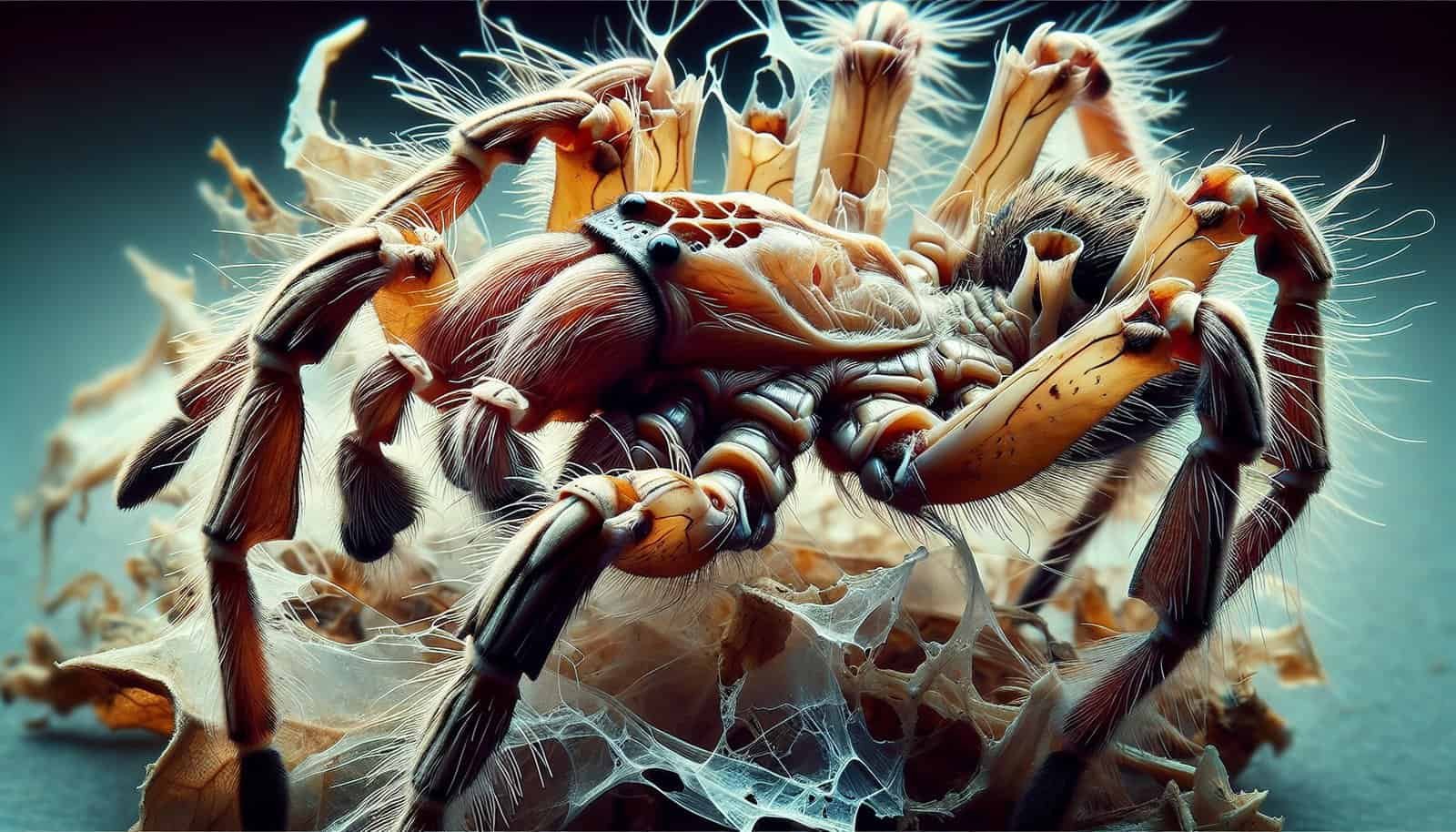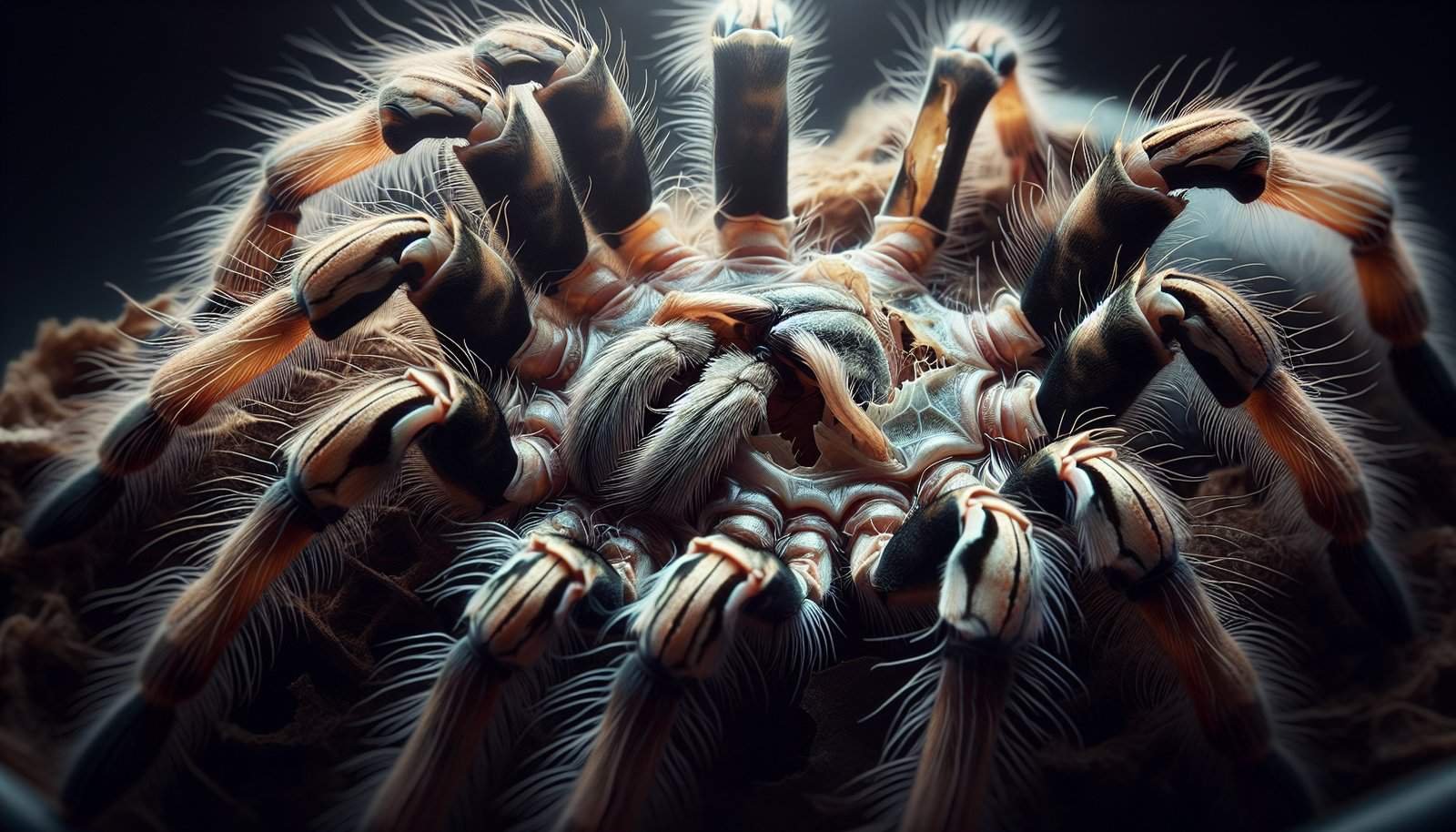Tarantulas, those fascinating eight-legged creatures, possess a spectacular ability to shed their exoskeletons as they grow, a process known as molting. But how can you tell if your tarantula is molting? Look out for signs such as a duller or darker coloration, the appearance of bald spots, reduced appetite, and a change in its behavior. These fascinating indicators can help you understand and appreciate your tarantula’s natural cycle of growth and renewal. So, next time you notice these common signs, rest assured that your arachnid friend is simply going through a fascinating molting stage!

Signs of Molting in a Tarantula
Molting is a natural process that tarantulas go through in order to grow and develop. It is an intricate and fascinating process that requires careful attention and observation. As a tarantula owner, it is important to be able to identify the signs of molting so that you can provide the necessary care and support to your furry friend. In this article, we will explore the various signs and indications of molting in tarantulas, as well as the steps you can take to ensure their well-being throughout the process.
Changes in Behavior
One of the first indicators that your tarantula is preparing to molt is a reduced appetite. Tarantulas typically have a healthy appetite, so a sudden loss of interest in food can be a strong signal that molting is imminent. This reduced appetite will often persist throughout the entire molting process. So, if your tarantula seems less interested in feeding, it might be time to start preparing for molting.
In addition to a decreased appetite, you may notice that your tarantula becomes more restless and active. It may start pacing around its enclosure, climbing on the walls, or even trying to escape. This restlessness is a natural instinct for tarantulas getting ready to molt. They are seeking the ideal spot for their molting process and trying to make themselves as comfortable as possible.
Another behavioral change that you might observe in your tarantula is increased aggressiveness. While tarantulas are generally docile creatures, they can become defensive or aggressive during the molting process. This aggression is their way of protecting themselves while they are in their most vulnerable state. So, if you see your tarantula displaying defensive behaviors such as hissing, rearing up, or flicking their hairs, it’s best to give them some space and avoid handling them during this time.
Physical Indications
Aside from changes in behavior, there are also physical indications that your tarantula is preparing to molt. One common sign is a cloudy or opaque exoskeleton. The exoskeleton, which is typically hard and shiny, becomes clouded and less transparent as the molting process approaches. This cloudiness is caused by the separation of the old exoskeleton from the new one that is forming underneath.
Another physical indication of molting is a drastic increase in size. As tarantulas grow, they outgrow their exoskeletons, and molting is their way of shedding the old, confining shell. Just before molting, tarantulas will typically appear bigger than usual, as their growing bodies prepare to shed their current exoskeleton and make room for the new one. So, if you notice your tarantula’s abdomen becoming significantly larger, it’s a strong sign that molting is on the horizon.
Additionally, you may observe darkening or discoloration in your tarantula’s exoskeleton. Some tarantulas may appear reddish or darker in color as they near the molting process. This darkening is thought to be a result of blood pooling in their exoskeleton, as their new exoskeleton develops. While this change in coloration may be subtle, it is worth monitoring as it can be an indication that molting is approaching.
Pre-Molting Preparations
Proper pre-molting preparations are crucial to ensure a smooth and successful molting process for your tarantula. Building a molting mat is one way to provide a safe and comfortable space for your tarantula to molt. A molting mat can be made using materials such as sphagnum moss, vermiculite, or a mixture of both. This material should be placed at the bottom of the enclosure, creating a soft surface for your tarantula to lay on during the molting process. The molting mat will help prevent any injuries or damage to their delicate new exoskeleton.
Creating a humid environment is another essential aspect of pre-molting preparations. Tarantulas require high humidity levels to successfully molt. This can be achieved by misting the enclosure with water or by using a humidifier. It is important to monitor the humidity levels regularly and make necessary adjustments to ensure that the environment remains adequately humid. Maintaining proper humidity is crucial in facilitating the molting process and preventing any complications that may arise from dry conditions.
Providing a safe and secluded space is also essential for your tarantula’s pre-molting preparations. As mentioned earlier, tarantulas become more restless and active before molting. They may seek out a secure spot to molt, such as burrowing underneath rocks or hiding in crevices. It is important to provide hiding places and a clutter-free environment to accommodate their needs. By creating a safe and secluded space, you can minimize stress and disturbance during the molting process.

Post-Molting Care
After your tarantula has completed the molting process, it is crucial to provide adequate post-molting care to ensure their well-being and a smooth recovery. One of the most important aspects of post-molting care is to avoid disturbance. Tarantulas are extremely vulnerable immediately after molting, as their new exoskeleton is soft and delicate. Any disturbances, such as handling or sudden loud noises, can cause significant stress and potentially lead to injury. Therefore, it is best to give your tarantula plenty of time to recover undisturbed.
Maintaining proper humidity levels is also important during the post-molting phase. The soft exoskeleton of your tarantula will harden and become more rigid over time. Adequate humidity helps facilitate this process and ensures that the new exoskeleton develops properly. Regularly monitor and maintain the humidity levels in the enclosure, misting or using a humidifier as needed. By providing the optimal humidity, you can support your tarantula’s recovery and help prevent any complications.
Offering food and water sparingly is another crucial aspect of post-molting care. During the immediate post-molting period, tarantulas do not have a strong appetite and are not typically interested in feeding. It is important to refrain from offering food during this time, as uneaten prey can potentially stress or harm a newly molted tarantula. Wait until your tarantula has fully hardened and regained its appetite before resuming regular feeding. Focusing on hydration is key, so offering a small water dish or lightly misting the enclosure can help keep your tarantula hydrated during this period.
Time Frame of the Molting Process
The molting process can vary in duration depending on several factors, including the size, species, and health of the tarantula. Each stage of the molting process, including preparing, molting, and hardening of the new exoskeleton, can take anywhere from a few days to several weeks.
The frequency of molting is also influenced by various factors. Young tarantulas, especially spiderlings, tend to molt more frequently than adults. As they grow and reach maturity, the molting frequency decreases. Additionally, the molting frequency can vary between different tarantula species. Some species molt more frequently than others, while some have longer intervals between molts. It is essential to research and understand the specific molting patterns and frequencies of the tarantula species you are caring for.

Molting Frequency in Different Tarantula Species
Different tarantula species have distinct molting frequencies. Some species, such as the Brachypelma smithi, commonly known as the Mexican Red Knee tarantula, molt approximately once a year. On the other hand, other species, like the Grammostola mollicoma, known as the Brazilian Black tarantula, may molt as infrequently as once every few years. It is important to research and understand the natural molting habits of the specific tarantula species you own to ensure proper care and anticipation for their molting needs.
Sexual Maturity and Molting
Molting plays a significant role in the sex determination of tarantulas. In many species, the ultimate molt commonly referred to as the “final molt,” is when males reach sexual maturity. This final molt is a crucial stage that determines if the tarantula is a mature male or a female. Males typically undergo physical changes during this final molt, such as developing hooks on their pedipalps, which they use for mating. It is an exciting and critical phase in a male tarantula’s life, as it signifies their readiness for reproduction.
During their final molts, mature males often exhibit changes in behavior. They may become more restless and start wandering in search of a mate. Their appetite may also decrease during this time. It is important to provide a suitable enclosure and space for a mature male tarantula to help facilitate their mating instincts. Additionally, it is crucial to bear in mind that male tarantulas typically have a shorter lifespan compared to females, as they often die soon after reaching sexual maturity.

Potential Complications During Molting
Molting is generally a complex and delicate process, and occasionally, complications can arise. One potential complication is a stuck molt, also known as incomplete molt. This occurs when the tarantula struggles to shed its old exoskeleton entirely, resulting in a partial molt. Stuck molts can be caused by factors such as inadequate humidity, improper diet, or improper handling during the molting process. If you suspect that your tarantula is experiencing a stuck molt, it is crucial to seek professional veterinary assistance to help address the situation and provide the necessary care.
Another potential complication is a failed molt, which is a more severe situation. Failed molts occur when the tarantula is unable to shed its old exoskeleton and becomes trapped inside it. This can lead to significant stress, injury, or even death if not promptly addressed. Failed molts are often caused by factors such as insufficient humidity, malnutrition, or underlying health issues. Recognizing the signs of a failed molt, such as immobility, discoloration, or abnormal positioning, is crucial so that immediate veterinary intervention can be sought to save the tarantula’s life.
Conclusion
Understanding the signs of molting in a tarantula is essential for providing appropriate care and support during this vital process. By recognizing changes in behavior, such as reduced appetite, restlessness, and aggressiveness, you can anticipate and prepare for molting. Physical indications, such as a cloudy exoskeleton, increased size, and darkening or discoloration, further validate your tarantula’s molting stage.
Proper pre-molting preparations, including building a molting mat, creating a humid environment, and providing a safe and secluded space, are critical for your tarantula’s well-being. Post-molting care involves avoiding disturbances, maintaining proper humidity levels, and offering food and water sparingly. Understanding the time frame and frequency of the molting process, as well as the unique characteristics of different tarantula species, will help you provide optimal care.
Molting is a natural and necessary process in a tarantula’s life cycle. By being attentive to the signs, taking preventive measures to avoid potential complications, and providing appropriate care, you can contribute to a favorable molting experience for your tarantula and ensure their continued health and well-being.

